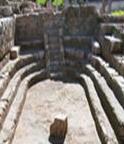The Library of Alexandria, 3rd century BCE
The Alexandria Library, built by the Greek-Egyptian king Ptolemy I around 300 B.C., was the greatest center of scholarship in the ancient world. The library was not only a repository of hundreds of thousands of papyrus scrolls (ancient books), but it was a research center where scholars compiled editions of Homer’s epics, scientists measured the size of the earth, and Euclid discovered the rules of geometry.
Until recently, however, all traces of the library remained hidden. Earlier this year, a Polish-Egyptian team of archaeologists excavating in the Bruchion section of Alexandria—where the royal compound of the Ptolemaic Dynasty was located—uncovered 13 large rooms, each equipped with an elevated podium. Archaeologists believe that these chambers functioned as lecture halls within the Alexandria Library.
In 48 B.C. a fire destroyed 400,000 of the library’s papyrus scrolls. In 30 B.C. Octavian (renamed Augustus by the Roman senate) conquered Alexandria and shifted the center of intellectual life to Rome. Although the Alexandria Library was never again the focal point of Western learning, it remained in use until the mid-seventh century, when it was destroyed by Arab Muslims.
“Field Notes,” Archaeology Odyssey, Sep-Oct 2004.
See also-





